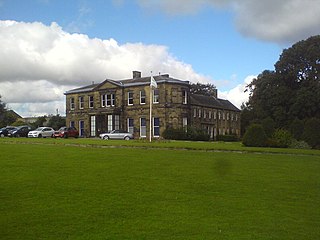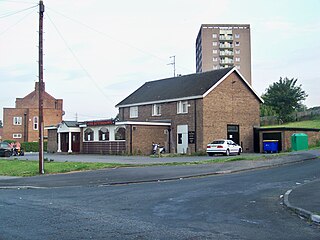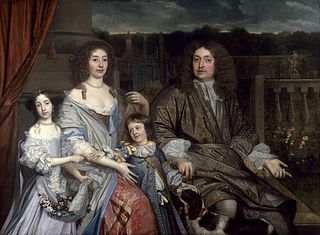Related Research Articles

Farnley Hall is a stately home in Farnley, west Leeds, West Yorkshire, England. It is a grade II listed building. It was built in Elizabethan times by the Danbys. The manor is recorded in the 1086 Domesday Book as Fernelei, so it is probable that this house was a replacement for earlier medieval structures.

Thomas Osborne, 1st Duke of Leeds,, was a prominent English politician. Under King Charles II, he was the leading figure in the government for around five years in the mid-1670s. He fell out of favour due to corruption and other scandals, and was impeached and eventually imprisoned in the Tower of London for five years until the accession of James II of England in 1685. In 1688 he was one of the Immortal Seven group that invited William III, Prince of Orange to depose James II as monarch during the Glorious Revolution. He was again the leading figure in government, known at the time as the Marquess of Carmarthen, for a few years in the early 1690s.

Duke of Leeds was a title in the Peerage of England. It was created in 1694 for the prominent statesman Thomas Osborne, 1st Marquess of Carmarthen, who had been one of the Immortal Seven in the Revolution of 1688. He had already succeeded as 2nd Baronet, of Kiveton (1647) and been created Viscount Osborne, of Dunblane (1673), Baron Osborne, of Kiveton in the County of York and Viscount Latimer, of Danby in the County of York, Earl of Danby, in the County of York (1674), and Marquess of Carmarthen (1689). All these titles were in the Peerage of England, except for the viscountcy of Osborne, which was in the Peerage of Scotland. He resigned the latter title in favour of his son in 1673. The Earldom of Danby was a revival of the title held by his great-uncle, Henry Danvers, 1st Earl of Danby.

Henry Compton was the Bishop of London from 1675 to 1713.

Farnley is a district in Leeds, West Yorkshire, England, 2 miles (3.2 km) south-west of Leeds city centre, between Wortley, Bramley and the countryside around Pudsey and Gildersome, in the LS12 Leeds postcode area. It is part of the Leeds City Ward Farnley and Wortley with a population of 24,213 according to the 2011 Census. New Farnley is a nearby commuter village.

Sir Robert Vyner, 1st Baronet was an English banker, goldsmith and Lord Mayor of London.
This is a list of those who have held the position of Lord Lieutenant of the West Riding of Yorkshire from its creation in 1660 to its abolition on 31 March 1974. From 1699 until 1974, all Lords Lieutenant were also Custos Rotulorum of the West Riding of Yorkshire. The incumbent Lord Lieutenant became in 1974 Lord Lieutenant of West Yorkshire, covering a smaller area.

Thomas Rhodes Armitage was a British physician, and founder of the Royal National Institute of Blind People.

Richard Hampden was an English Whig politician and son of Ship money tax protester John Hampden. He was sworn a Privy Counsellor in 1689 and was Chancellor of the Exchequer from 18 March 1690 until 10 May 1694.

The Coat of arms of Leeds City Council derives its design from the seventeenth century. In 1662 the Borough of Leeds received a new charter which created the office of mayor, and the arms seems to date from about this time as they incorporate part of the arms of the first mayor. These arms were recorded at the heraldic visitation of Yorkshire in 1666. By the time that the borough was reformed by the Municipal Corporations Act 1835, silver owls had been added both as crest above the shield, and as supporters on either side. These additions were not authorised, however, and in 1920 application was made by Leeds County Borough Council to the College of Arms to have these additions officially granted. In the following year the grant of crest and supporters was made, with the colouring of the owls altered to "proper", or natural colourings. Gold ducal coronets were added to the supporters for further heraldic difference.

Leeds Thomas Danby was a further education college in Leeds, West Yorkshire, England offering courses for 16- to 18-year-olds and adults. The college was named after the first Mayor of Leeds, Captain Thomas Danby of Farnley. On 1 April 2009, Leeds Thomas Danby merged with Park Lane College and the Leeds College of Technology to form the new Leeds City College.
Thomas Danby may refer to:

Sir John Robinson, 1st Baronet, of London was an English merchant and politician who sat in the House of Commons between 1660 and 1667. He was Lord Mayor of London in 1662.
Sir Thomas Danby was an English landowner and politician who sat in the House of Commons between 1640 and 1642. He supported the Royalist side in the English Civil War.
Edward Parker, 12th Baron Morley was an English peer, Lord of Morley, Hingham, Hockering, &c., in Norfolk, the son of Henry Parker, 11th Baron Morley and Lady Elizabeth Stanley.
James Smith was a clergyman who became Archdeacon of Barnstaple in 1660. He was also much admired for his wit, and collections of his satirical verse were published in the 1650s.
Bullen Reymes was an English courtier, diplomat and politician who sat in the House of Commons from 1660 to 1672. He fought in the Royalist army in the English Civil War.

Thomas Lascelles, also spelt Lassells, was an English radical politician and businessman of the second half of the 17th century. He is now best known for the construction of Mount Grace Manor House, one of the few extant examples of architecture from the 1649 to 1660 Commonwealth or Protectorate.
Sir Christopher Danby MP JP, of Farnley, Masham, and Thorp Perrow, Yorkshire, of St. Paul's Cray, Kent, and of Kettleby, Lincolnshire, and of Nayland, Suffolk, was an English politician.
References
- 1 2 Kirby, J.W. (1986) Northern History p 123 "Restoration Leeds and the Aldermen of the Corporation 1661–1700"
- 1 2 Leeds Civic Trust Archived 27 May 2011 at the Wayback Machine Leeds Coat of Arms
- ↑ Cliffe, J. T. (2008). "Danby family (per. 1493-1667)" (available online to subscribers only). Oxford Dictionary of National Biography, online edition. Oxford University Press. Retrieved 5 October 2010.
- ↑ Middlesex Sessions Rolls 1667 31 July and 1 August